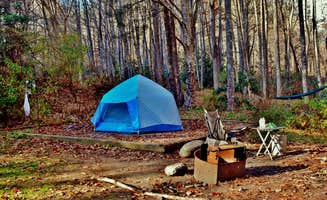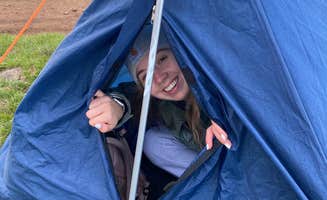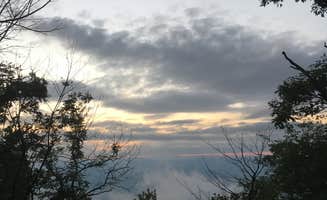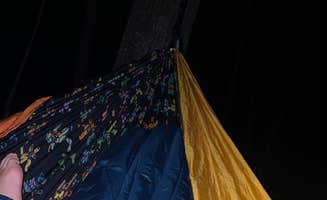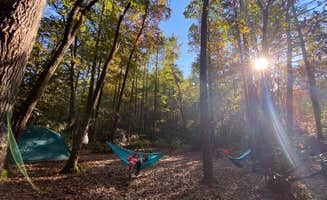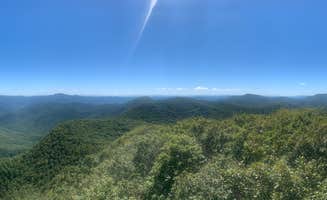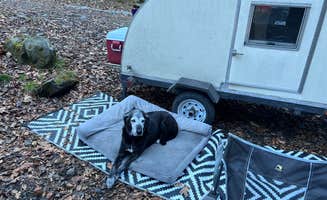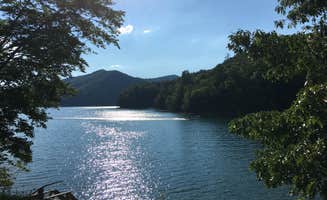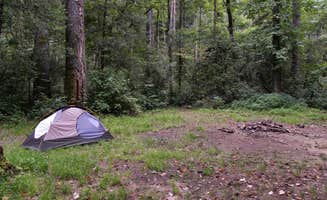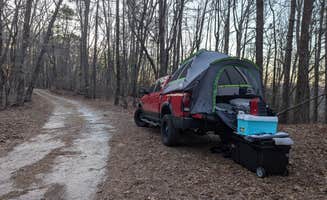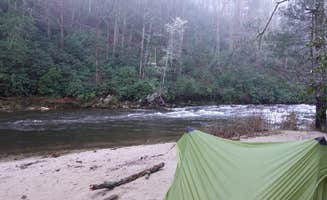The mountainous terrain surrounding Sylva, North Carolina offers numerous dispersed camping options within Nantahala National Forest, with elevations ranging from 2,000 to over 6,000 feet. Free camping near Sylva, North Carolina typically requires visitors to navigate forest service roads that vary significantly in quality, from relatively smooth gravel to deeply rutted paths. Winter temperatures at higher elevations can drop below freezing even in late spring, requiring appropriate cold-weather gear year-round.
What to do
Waterfall exploration: 5 miles from camping areas. At Blue Valley Dispersed Camping, several trailheads lead to nearby waterfalls. As one camper noted, "There's a little trail to a waterfall after you go down the old logging road and follow the path across the creek. Very short, very easy about 0.5 mile or less from the creek."
Summit hiking: 4-5 hour round trip. Trails from many dispersed sites connect to peaks with panoramic views. At Whiterock Mountain Backcountry Campsite, "The split is clearly marked and will take you up a short (slippery) climb to this incredible overlook. The campsite itself is large enough for 1 or 2 tents and has several nice established fire pits."
Sunrise viewing: 30-minute pre-dawn hike required. Early risers can catch spectacular mountain vistas. At Wesser Bald Fire Tower, "We always do this hike for sunrise since it is a quick trek up and gives the best views of the area. Camping here is also nice but not the most comfortable."
What campers like
Riverside sites: natural sound barrier. Many campers appreciate sites positioned along flowing water. "We have camped at 3 sites at this campground and have loved all of them. We were very secluded and there was very little traffic on the dirt road. Love hearing all the wonderful sounds of nature and nothing else. Wonderful creek/river by every campsite we went to."
Bald mountain views: above-cloud camping experiences. Campers seeking elevated perspectives can find spots above the cloud line. At Black Balsam Knob - Dispersed Camping, "Lots of places to set up camp. We set up below the mountain, but there are spots at the top as well. The clouds are amazing you are basically in them or above them."
Group-friendly clearings: sites accommodate multiple tents. Several areas offer space for larger groups. One camper at Upper Cove Creek - UCC1 Dispersed described it as a "Beautiful free group camping area with large parking lot. All dirt roads back here."
What you should know
Severe weather preparation required. Mountain weather changes rapidly and can be harsh even in summer. "The sunset was breathtaking and the hike was very fun but if you are camping overnight, expect wind gusts that are capable of snapping tent poles. There is very little wind coverage at the top of the mountain."
GPS limitations: download offline maps. Navigation tools often fail in remote areas. One camper at Blue Ridge Roadside Campsites "Spent 20 minutes trying to find this campground from where the GPS took us. Never found it."
National Forest regulations enforced. Forest Service rangers actively patrol dispersed camping areas. "You MUST camp outside of 1000ft from road. You WILL get investigated by park Rangers, which stepped up enforcement of this stupid, pointless law around 2 years ago."
Tips for camping with families
Choose sites with creek access: natural entertainment. Children enjoy exploring shallow stream areas common to many dispersed sites. "Beautiful, large, private sites. You couldn't see our site from the road, huge site, lots of woods surrounding for kids to play and explore, right beside a gorgeous large creek."
Pack extra layers year-round. Even summer nights require warm sleeping gear at higher elevations. "Perfect for tent camping right off the Blue Ridge Parkway. Campsites are next to the road under the pine trees or you can camp on top of the mountain."
Flat Laurel Creek Trail: kid-friendly hiking. This trail offers manageable terrain for younger hikers while still providing mountain views. "The Flat Laurel Creek Trail starts at these campsites and goes to Sam Knob, which is a 6,000 foot peak."
Tips from RVers
Vehicle clearance requirements: 6+ inches recommended. Road conditions limit access for larger vehicles. One visitor noted, "Good place for me to overnight, there are no facilities, the entrance is a bit hidden google maps will get you very close look for the small tent sign on your right when headed away from the parkway my nv200 did not have a problem navigating but watch the potholes."
Size restrictions: smaller is better. Most no-cost camping opportunities near Sylva limit vehicle size. At Bartram Trail Campground near Franklin, one camper mentioned it's "a little smaller but it works as an option if necessary."
Water crossing assessment: scout before attempting. Some camp areas require crossing small streams. "When I arrived the pavement ended and continued onward on a very primitive gravel road. Pretty rough in some places and very narrow, let's just say I wouldn't want to end up encountering another car."


